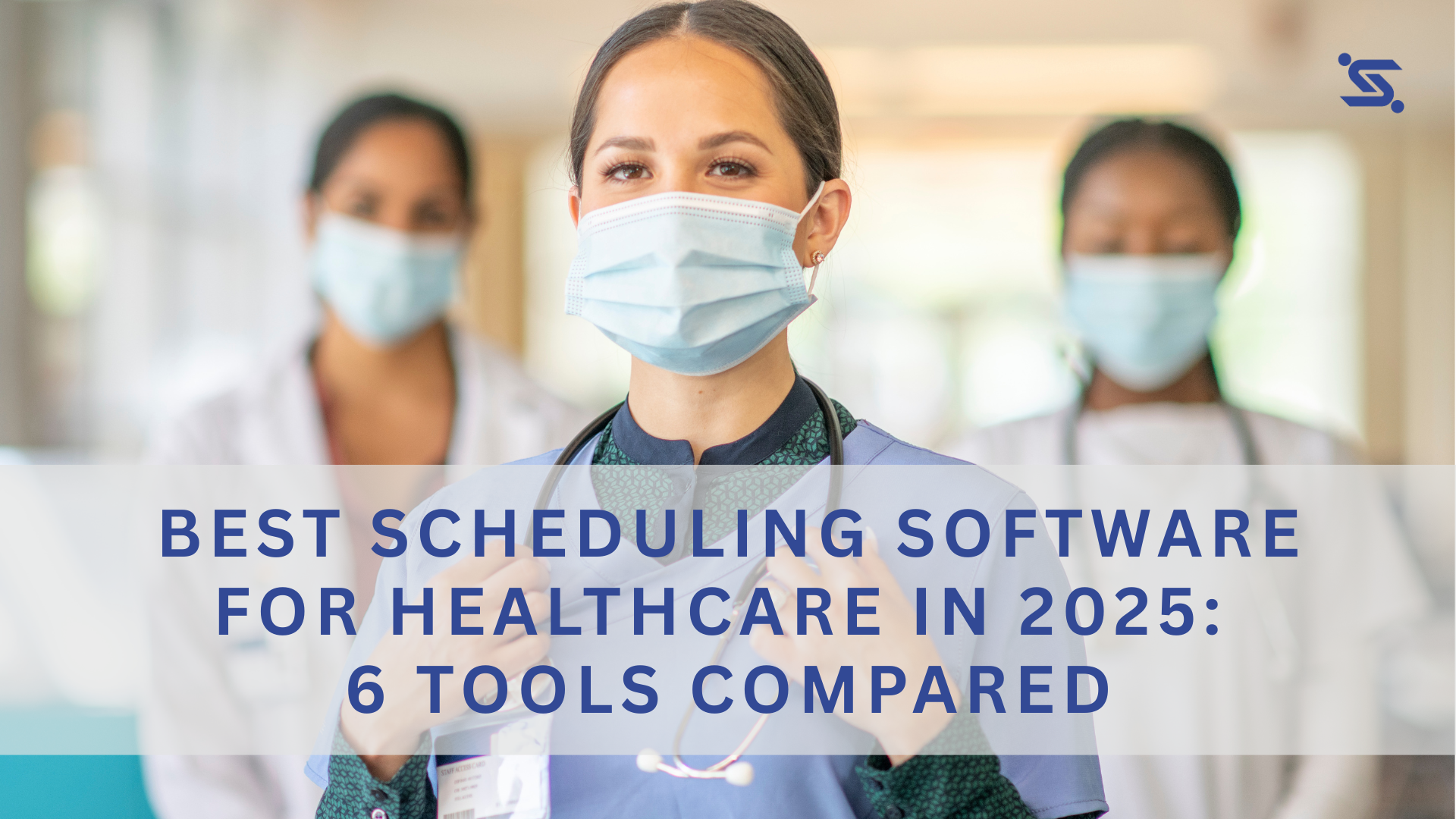Introduction: Why healthcare scheduling is different
In most industries, scheduling is about matching people to shifts. In healthcare, it’s about far more: patient safety, union agreements, regulatory compliance, fatigue prevention, and the morale of frontline teams who are already stretched thin.
Unlike retail or hospitality, hospitals and social service organizations can’t afford scheduling errors. A missed shift can mean understaffed wards, unsafe patient ratios, and burned-out nurses. That’s why the choice of scheduling software matters more in healthcare than almost anywhere else.
But with dozens of tools on the market, which ones actually fit the realities of healthcare?
In this article, we review six widely used scheduling platforms — some built for healthcare, some more general — to help leaders make informed choices.
What to look for in healthcare scheduling software
When evaluating scheduling platforms for healthcare and social services, these factors should be top of mind:
- Healthcare-specific compliance – support for union rules, credential tracking, fatigue prevention, and fairness logic.
- Smart scheduling – rotation builder, managing full time and volunteer staff, instant shift creation and scheduling calendar, partial shift acceptance
- Fairness & equity – features that give all staff an equal chance to accept shifts, reducing burnout and turnover.
- Ease of use – mobile-first, intuitive design so frontline teams adopt it quickly.
- Analytics & overtime management – visibility into fill rates, staffing gaps, and costs.
- Ease of integration – A tool that has stand alone modules, can be easily used and integrated with existing WMS in organisations
- Scalability – ability to support anything from small clinics to large hospital systems.
The 6 tools compared
1. UKG (Ultimate Kronos Group)
Overview: A global workforce management platform, widely used across industries, including healthcare.
- Key Features: Broad HR + payroll + scheduling suite, strong compliance modules, analytics.
Pros:
- Enterprise-grade, integrated HR and scheduling.
- Proven scalability for large systems.
- Strong reporting and compliance.
Cons:
- Lengthy, costly and complex implementation cycles.
- Designed for multiple industries, workflows can feel rigid for frontline healthcare.
Best For: Large hospital networks already using UKG for HR/payroll who want a single, integrated system.

2. StaffStat
Overview: A Canadian tool focused on healthcare, especially long-term care.
- Key Features: Call-out automation, simple scheduling, compliance tracking.
Pros:
- Built with healthcare in mind.
- Strong adoption in Canadian long-term care and retirement homes.
- Easy-to-use interface for schedulers.
- Provides basic callout automation via app/email.
Cons:
- More tailored to LTC than acute-care hospital scale scheduling.
- Less innovation compared to newer SaaS competitors. (For instance, no rotation builder)
- Limited integration capabilities
- Minimal union transparency for healthcare compliance
Best For: Long-term care facilities seeking a simple, healthcare-aligned solution.
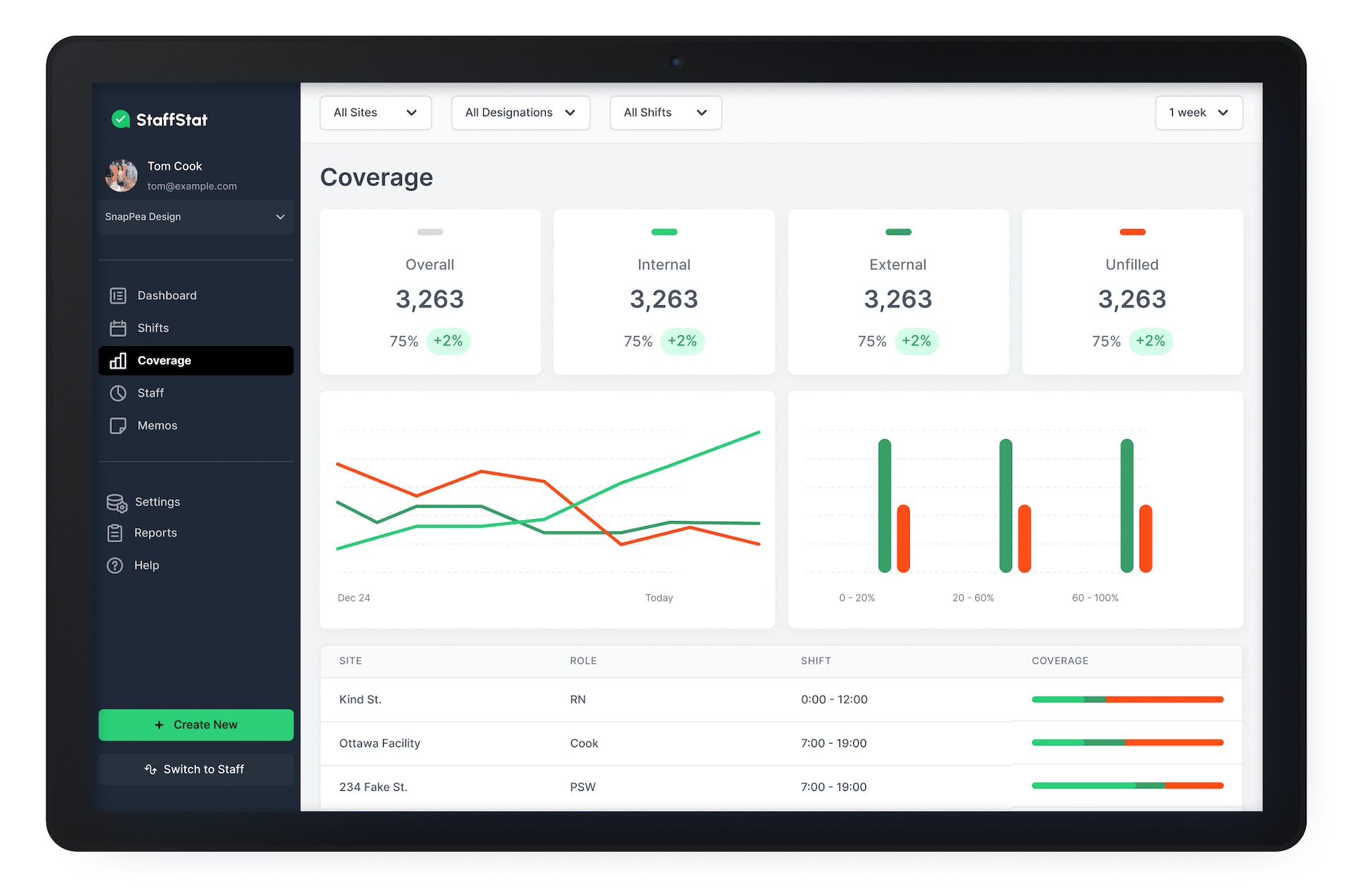
3. When I Work
Overview: A well-known scheduling platform serving multiple industries, including healthcare.
- Key Features: Mobile-first design, time & attendance, integrations with payroll.
Pros:
- Intuitive and easy for staff to adopt.
- Supports shift swapping and time-off requests.
- Scales well for small-to-mid-sized facilities.
Cons:
- Not healthcare-specific — designed for broad industries rather than hospitals.
- Compliance and union rules require custom setup or workarounds.
- May not fully address complex collective bargaining agreements (CBAs) or seniority-based scheduling out-of-the-box.
- Schedule view often requires scrolling through long list of staff names
Best For: Clinics or mid-sized healthcare organizations looking for a simple, user-friendly scheduling tool.
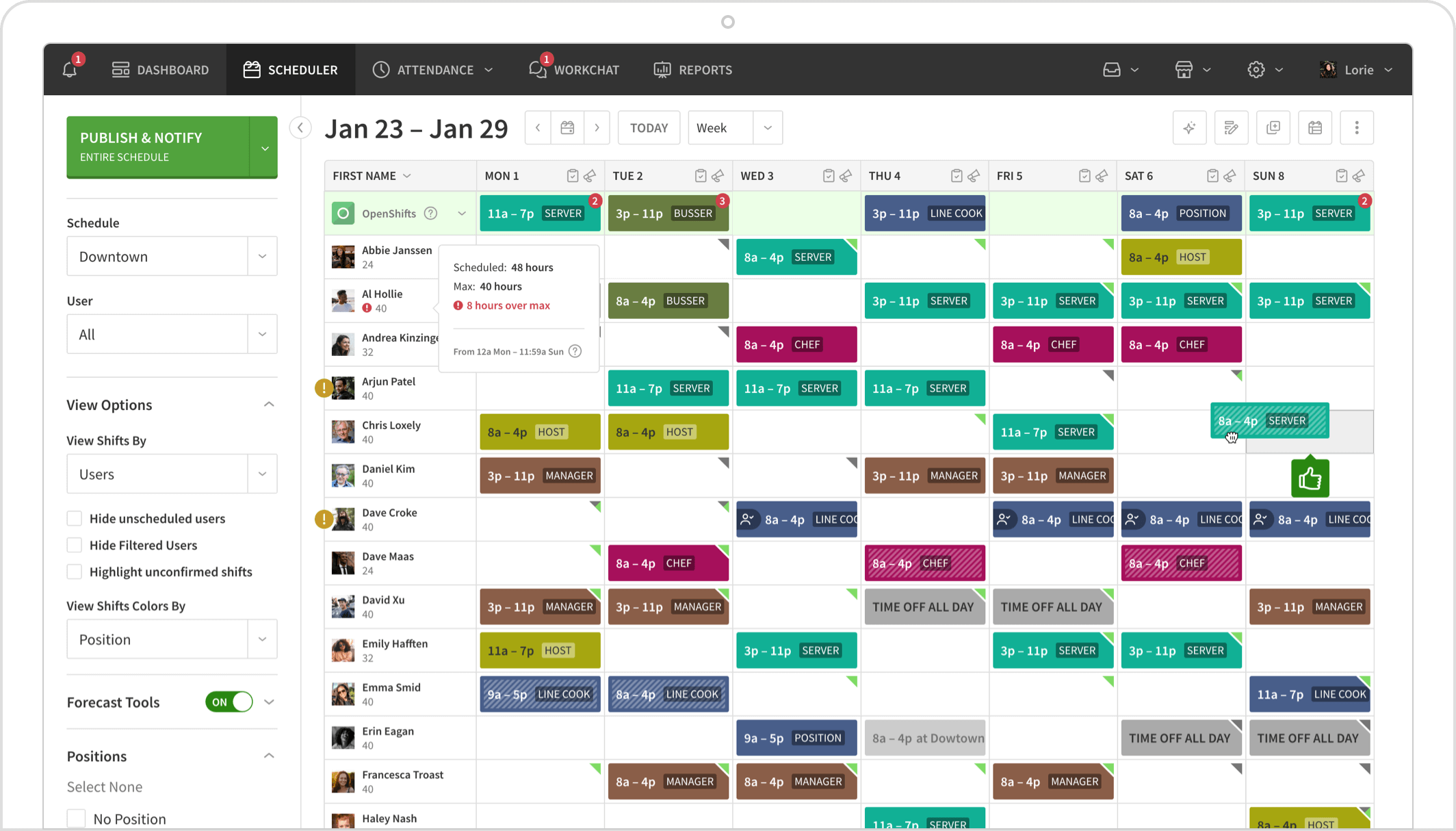
4. Connecteam
Overview: A mobile-first workforce app with strong adoption among deskless teams, including healthcare.
- Key Features: Drag-and-drop scheduling, AI recommendations, HIPAA-compliant communication, GPS time clock.
Pros:
- All-in-one: scheduling, communication, task management.
- HIPAA-compliant messaging for patient-related updates.
- Offers a free plan for small teams.
Cons:
- Broad industry focus — not exclusively healthcare.
- Some integrations still in development.
Best For: Healthcare organizations that want an affordable, all-in-one workforce management tool with strong mobile adoption.

5. Vocantas
Overview: A Canadian vendor specializing in automated communications and workforce call-outs.
- Key Features: Interactive voice response (IVR), automated notifications, staff surveys.
Pros:
- Strong at bulk communication and call-out automation.
- Effective for large-scale staffing alerts.
- Supports union rules like ONA pension overtime
Cons:
- Primarily a communication tool, not a full scheduling system.
- Less intuitive for day-to-day scheduling needs.
- No rotation builder, Limited audit trails for grievances
- ROI limited to callout efficiency
- Less evidence at large hospital scale
Best For: Organizations needing mass shift notifications alongside another scheduling solution.
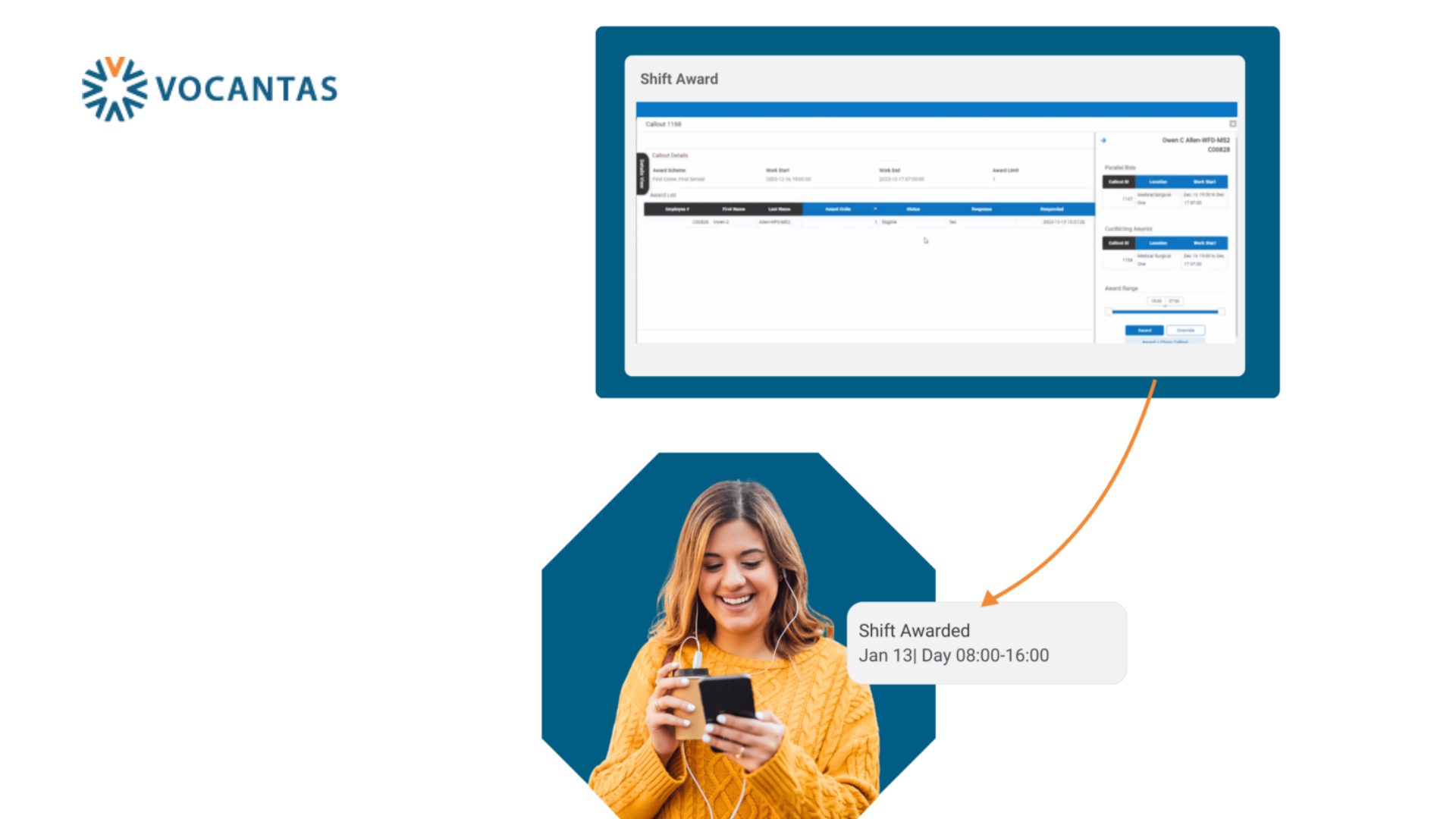
6. ShiftLink
Overview: Purpose-built scheduling software for healthcare and social services.
- Key Features: Equitable and transparent, union compliance, short and longcall out functions, time-stamped history and audit capable, AI-powered rotation builder.
Pros:
- Purpose-built for healthcare and social services.
- Mobile-first, easy for frontline staff to adopt.
- Rules-based AI scheduling: rotations, callouts, automation.
- Advanced analytics and reporting for HR leaders.
- Full audit transparency to support healthcare and union compliance.
- Seamless integrations (Avanti, Meditech, SAP, UKG) with a roll out time of 8 weeks*
- Built-in communication and real-time notifications.
- Implement in 8 weeks
- 24/7 support
Cons:
- Narrower industry focus — not designed for retail or corporate use.
Best For: Hospitals (Small to large), shelters, and social service organizations that need healthcare-specific scheduling built around fairness and compliance.

Why staff-centered scheduling improves patient care
It’s easy to see scheduling as logistics. But in healthcare, scheduling is culture.
When staff trust the scheduling process — knowing it’s fair, transparent, and respectful of their lives — they stay longer, engage more, and deliver better care. Research shows that healthcare worker burnout and turnover are directly linked to patient safety outcomes.
At The Salvation Army Centre of Hope in London, Ontario, ShiftLink became part of a psychologically safe workplace policy, credited with reducing anxiety and increasing fairness for frontline staff. That kind of impact can’t be measured in dollars alone — it’s about the human connection that sustains patient care.
A quick comparison
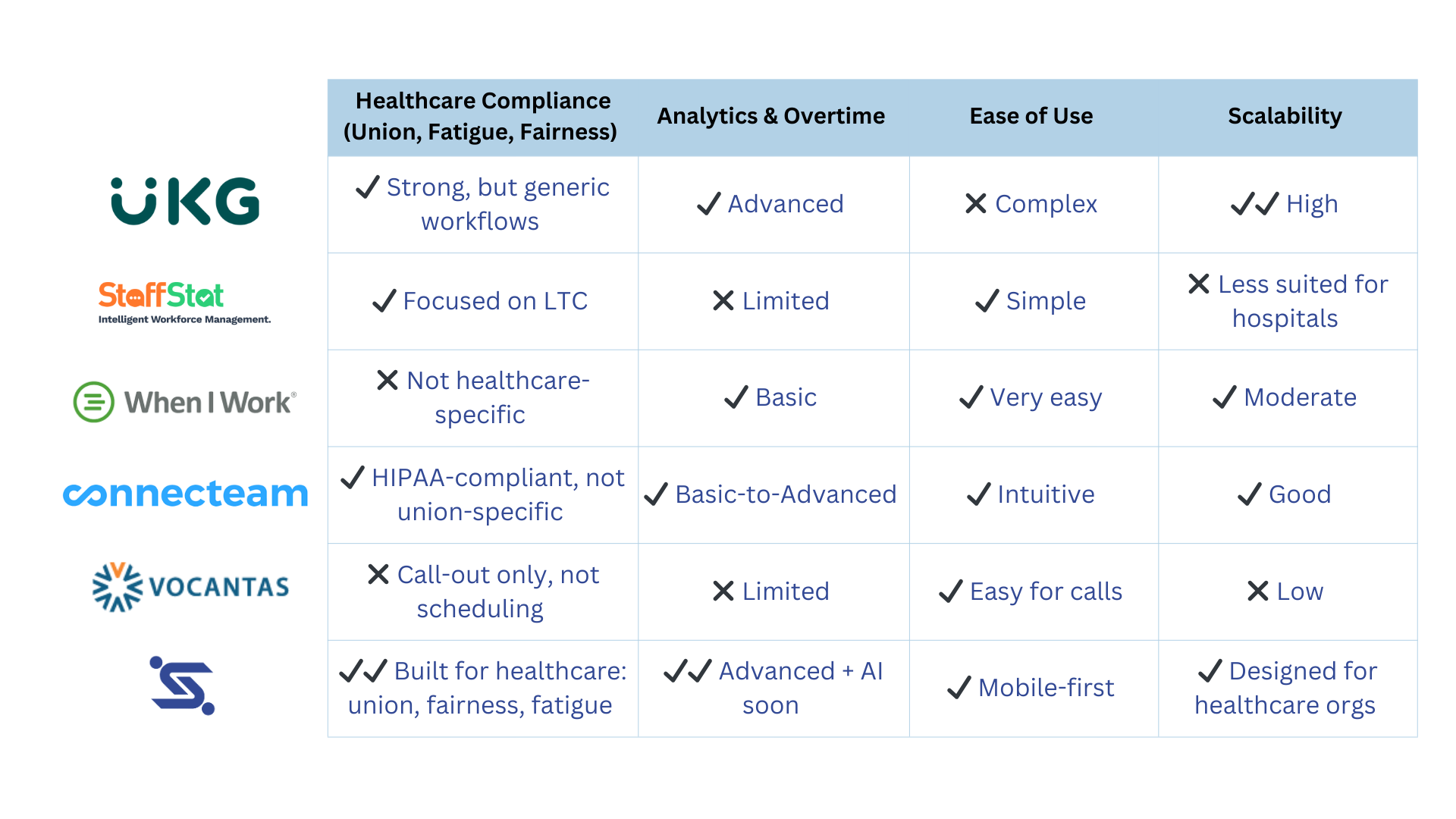
Why ShiftLink stands out
Unlike generalist tools that stretch across industries, ShiftLink is purpose-built for healthcare and social services. Every feature is designed with frontline realities in mind — from union rules and fairness logic to overtime management and psychological safety.
Key differentiators:
- Healthcare-first design: Built collaboratively with hospital staff, both frontline and management.
- Fairness & equity: Features like Time-Out and partial shift acceptance ensure every staff member has fairness, equity and transparency with equal access to shifts. Time-stamped records help to eliminate grievances and enhance labour relations.
- Smarter communication: Broadcast messages, notes, and resource links let leaders share critical info instantly — no external apps needed.
- AI-powered scheduling: From rotations to callouts, ShiftLink automates complex scheduling while respecting fatigue, compliance, and staff preferences.
- Analytics for leaders: Heat maps, engagement insights, and custom reports make staffing decisions data-driven.
- Proven ROI: Reduced overtime, fewer grievances, and measurable FTE savings across Canadian hospitals and social service organizations.
- Seamless integrations: Works with Avanti, Meditech, SAP, UKG, and other enterprise systems.
The bottom line
Where others adapt into healthcare, ShiftLink was born in it. That means less compromise, faster adoption, and stronger results for frontline teams and leaders alike.

Conclusion: Choosing the right fit
Each of these platforms brings strengths to the table:
- UKG = enterprise powerhouse.
- StaffStat = proven for long-term care.
- When I Work & Connecteam = accessible, user-friendly, but not healthcare-exclusive.
- Vocantas = strong at communication, weaker at scheduling.
- ShiftLink = healthcare specialist, built for the realities of hospitals, shelters, and social services.
The right choice depends on your organization’s size, priorities, and culture. But if you want fairness, compliance, and patient care at the heart of your scheduling, ShiftLink stands apart as the healthcare-first solution.
👉 Ready to see how staff-centered scheduling can transform retention and patient outcomes?
Discover ShiftLink.


